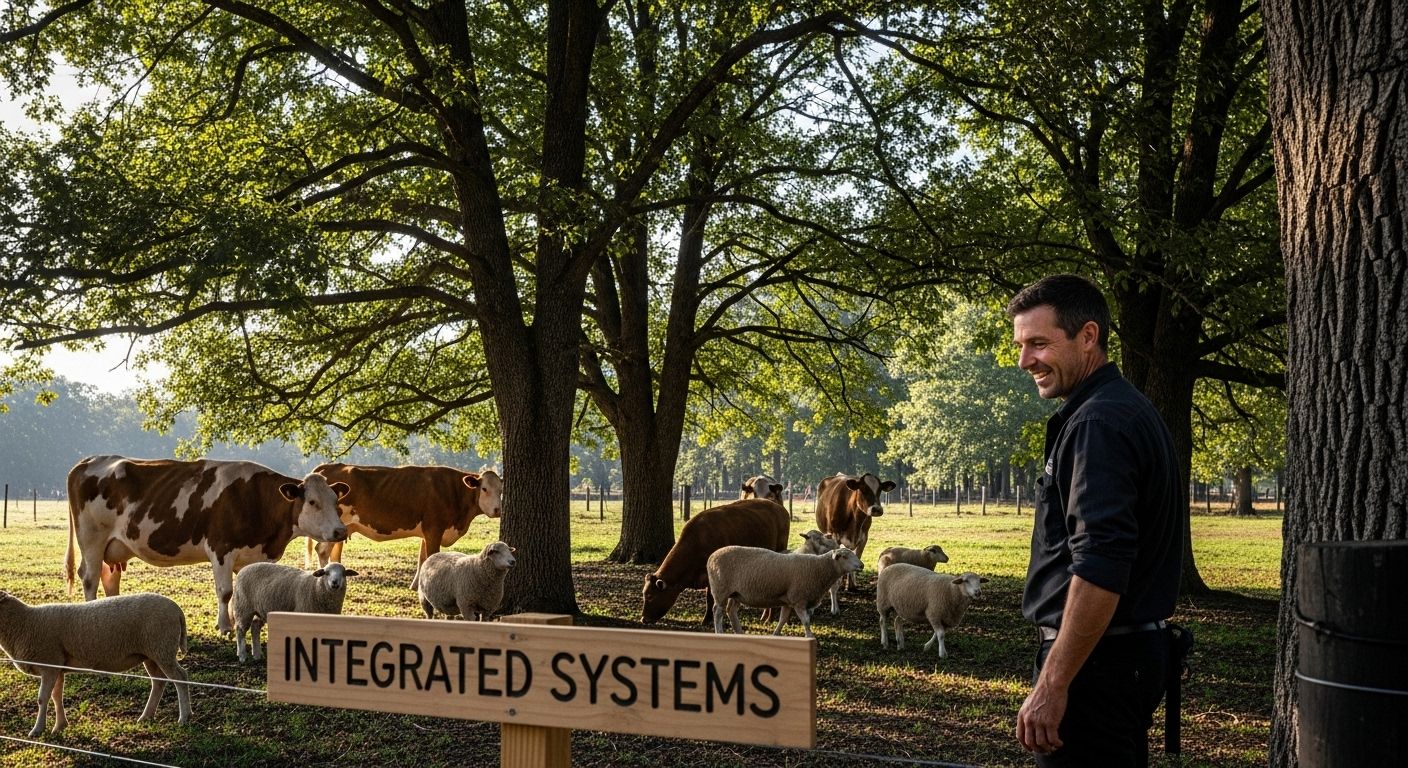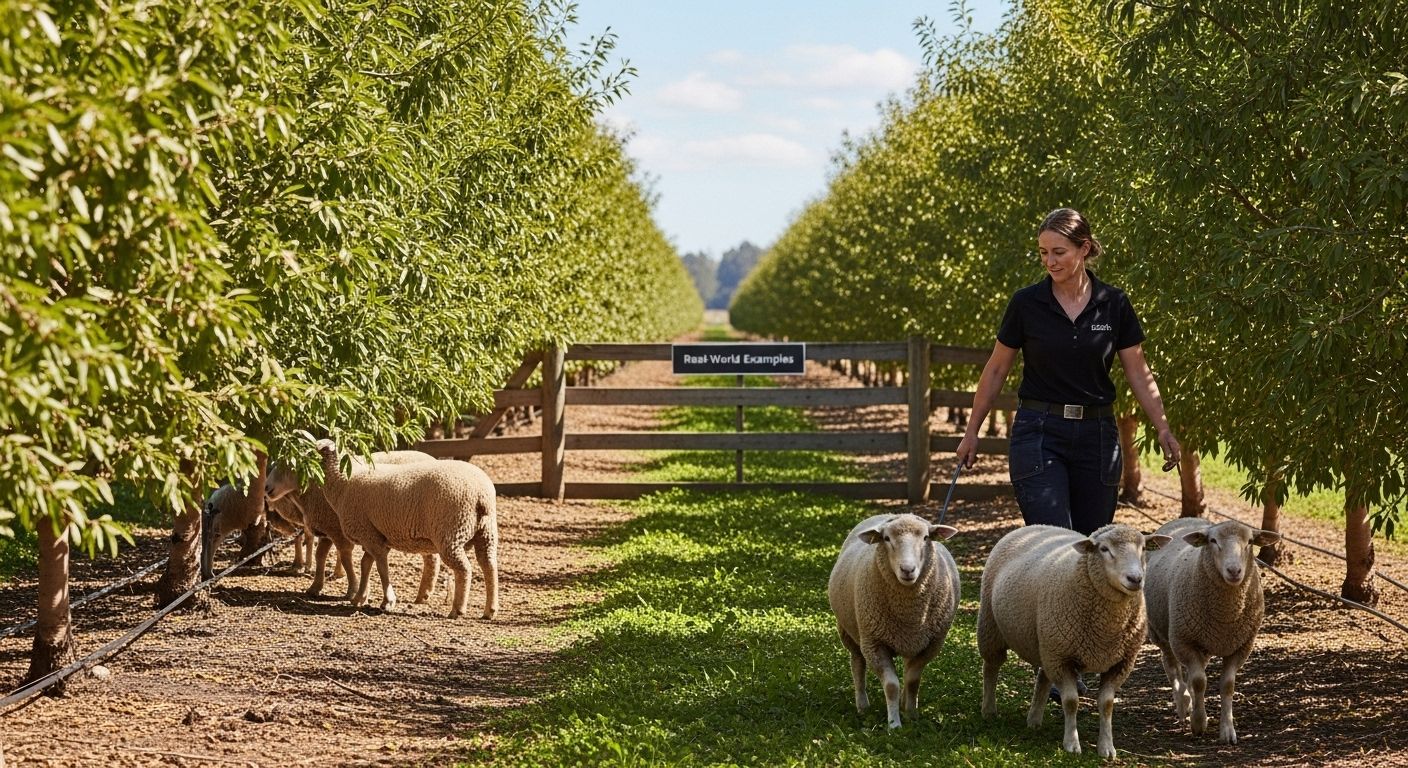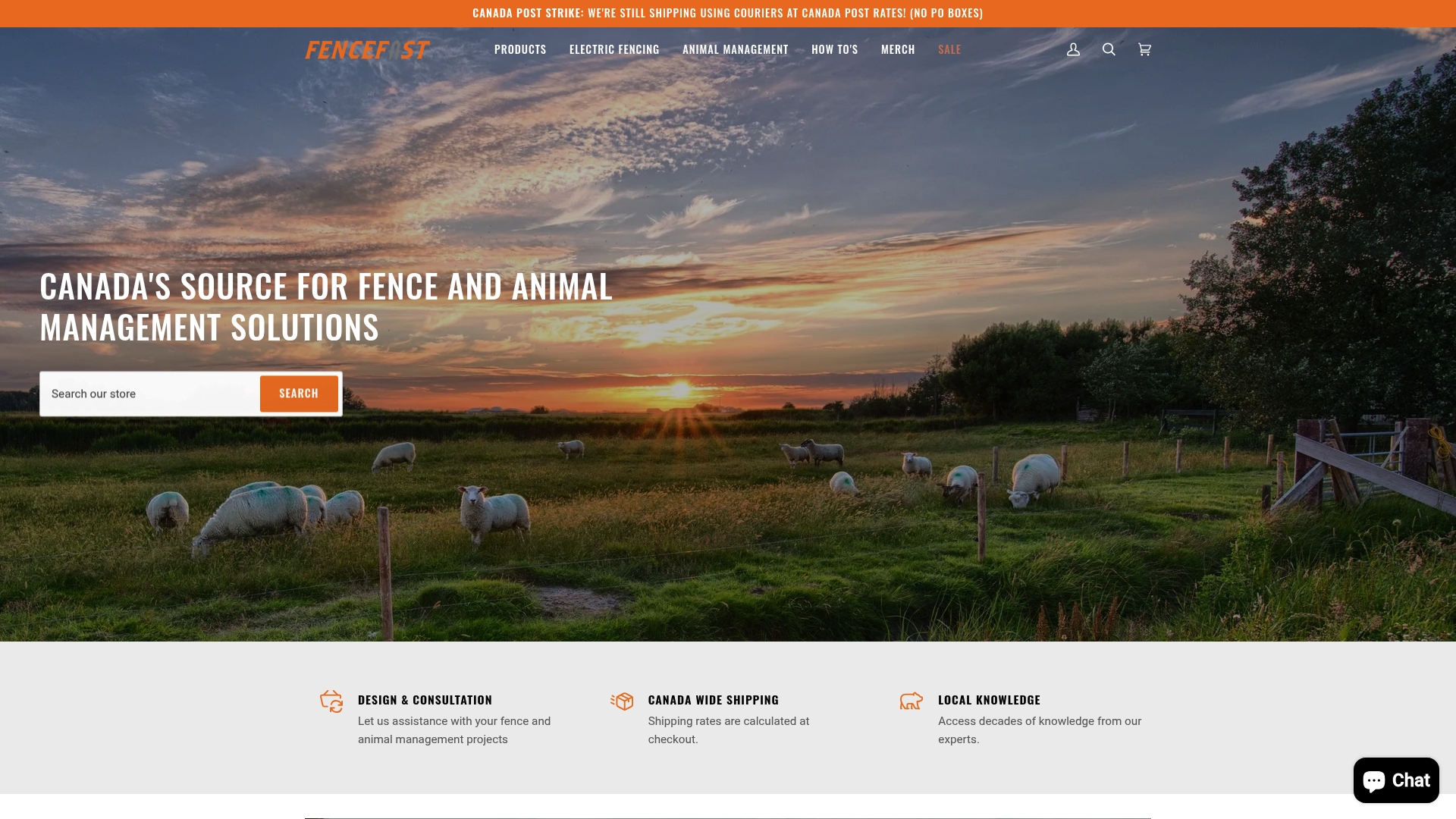
Farmers have started blending trees and livestock on the same land and the results are changing how we look at agriculture. In fields that combine animals and trees, land captures significantly more carbon than traditional pastures and farmers see multiple income streams from the very same acre. It sounds like a compromise, but the surprise is silvopasture actually improves animal welfare, land health, and profit—all at the same time.
Table of Contents
- Defining Silvopasture: A Blend Of Trees And Livestock
- The Importance Of Silvopasture In Sustainable Agriculture
- How Silvopasture Benefits The Environment And Economy
- Key Principles And Practices Behind Silvopasture
- Real-World Examples Of Successful Silvopasture Systems
Quick Summary
| Takeaway | Explanation |
|---|---|
| Integrate trees and livestock for better productivity | Silvopasture combines trees and pasture, enhancing land use and generating multiple agricultural products simultaneously. |
| Implement rotational grazing to protect ecosystems | Use planned grazing strategies to safeguard tree growth while promoting healthy forage production for livestock. |
| Enhance carbon storage through silvopasture | This method captures more carbon than traditional practices, contributing to climate change mitigation and environmental restoration. |
| Diversify income streams for economic resilience | Farmers can produce timber, livestock, and forage, reducing financial risks linked to single-crop farming systems. |
| Select compatible species for successful integration | Careful choice of trees and forage types is essential for maximizing mutual benefits and ensuring ecological balance. |
Defining Silvopasture: A Blend of Trees and Livestock
Silvopasture represents an innovative agricultural approach that harmoniously integrates trees, livestock, and pasture into a single productive ecosystem. Unlike traditional farming methods that separate woodland and grazing areas, silvopasture creates a symbiotic environment where animals, vegetation, and landscape work together.
The Core Concept of Integrated Agriculture
At its heart, silvopasture is about strategic land management that maximizes ecological and economic benefits. According to the USDA National Agroforestry Center, this method deliberately combines trees, forage, and grazing livestock as a unified system. The key distinction is intentional design and active management.
Critical components of silvopasture include:
- Carefully selected tree species that provide multiple benefits
- Strategically managed grazing patterns
- Intentional forage production
- Balanced ecosystem interactions
Environmental and Agricultural Benefits
Silvopasture offers multiple advantages that extend beyond traditional agricultural practices. Livestock gain shade and shelter, trees receive protection and nutrient cycling, and the overall landscape becomes more resilient. Farmers utilizing this approach can simultaneously produce timber, livestock, and forage crops while improving land health.
To help clarify the unique features of silvopasture, this table summarizes its main ecological and economic benefits compared to traditional pasture systems as discussed in the article.
| Characteristic | Silvopasture System | Traditional Pasture System |
|---|---|---|
| Carbon Sequestration | High (trees and soil capture more carbon) | Low to moderate |
| Income Streams | Multiple: timber, livestock, forage | Usually single (livestock or forage) |
| Biodiversity | Enhanced (supports diverse species) | Limited |
| Soil Health | Improved (nutrient cycling, less erosion) | Moderate to poor |
| Animal Welfare | Better (shade, shelter, diverse forage) | Lower (exposed, limited forage variety) |
| Climate Resilience | Greater (trees buffer climate impacts) | Lower |
The system creates a microclimate that supports animal welfare and plant growth. Trees reduce temperature extremes, protect against wind, and provide additional nutrition through fallen leaves and fruits. Livestock, in turn, help manage vegetation and contribute natural fertilization through their grazing and manure.
By integrating multiple agricultural elements, silvopasture represents a sophisticated approach to land management that delivers economic productivity and environmental sustainability.
The Importance of Silvopasture in Sustainable Agriculture
Silvopasture emerges as a transformative agricultural strategy that addresses multiple environmental and economic challenges facing modern farming systems. By integrating trees, livestock, and pasture, this approach offers comprehensive solutions to sustainability challenges that traditional agricultural methods struggle to resolve.
Ecological Impact and Carbon Management
According to the USDA Forest Service National Agroforestry Center, silvopasture provides substantial environmental benefits that extend far beyond traditional land management practices. Carbon sequestration becomes a critical advantage, with integrated systems capturing and storing significantly more carbon compared to conventional pastures.
Key ecological advantages include:
- Reduction of greenhouse gas emissions
- Enhanced biodiversity across agricultural landscapes
- Improved soil health and water retention
- Mitigation of climate change impacts
Economic Resilience for Agricultural Systems
Beyond environmental benefits, silvopasture creates economic diversification for farmers. The integrated system allows simultaneous production of multiple agricultural products—livestock, timber, and forage crops—creating multiple revenue streams from a single land area. This approach reduces financial risks associated with single-crop or single-livestock farming models.

Farmers implementing silvopasture can expect:
- Increased land productivity
- Reduced input costs
- Enhanced animal welfare conditions
- More stable and resilient agricultural income
By reimagining agricultural landscapes as complex, interconnected ecosystems, silvopasture represents a sophisticated approach to sustainable food production. The method demonstrates how strategic land management can simultaneously address environmental conservation, animal welfare, and economic sustainability—offering a holistic solution to modern agricultural challenges.
How Silvopasture Benefits the Environment and Economy
Silvopasture represents a sophisticated agricultural approach that delivers substantial environmental and economic advantages through integrated land management. By thoughtfully combining trees, livestock, and pasture, farmers can create systems that generate multiple benefits simultaneously.
Environmental Restoration and Climate Mitigation
According to a comprehensive field study in the mid-southern U.S., silvopasture systems demonstrate remarkable ecological potential. Carbon sequestration becomes a primary mechanism for environmental restoration, with integrated systems capturing significantly more carbon than traditional agricultural landscapes.
Environmental benefits include:
- Enhanced carbon storage in vegetation and soil
- Reduced soil erosion
- Improved water retention and quality
- Increased habitat diversity for wildlife
Economic Efficiency and Diversification
Beyond environmental advantages, silvopasture creates remarkable economic opportunities for agricultural producers. The integrated system allows farmers to generate multiple revenue streams from a single land area, dramatically improving economic resilience and land productivity.
Economic advantages encompass:
- Multiple product generation (timber, livestock, forage)
- Reduced input costs
- Enhanced land use efficiency
- Increased overall farm profitability
By reimagining agricultural landscapes as complex, interconnected ecosystems, silvopasture offers a transformative approach to sustainable food production. This method demonstrates how strategic land management can simultaneously address environmental conservation, economic sustainability, and agricultural productivity—providing a holistic solution to modern farming challenges.
Key Principles and Practices Behind Silvopasture
Silvopasture represents a sophisticated agricultural strategy that demands careful planning, strategic design, and ongoing management. Understanding its core principles is essential for farmers seeking to implement this integrated land management approach effectively.
Strategic Design and Species Selection
According to the USDA National Agroforestry Center, successful silvopasture hinges on deliberate integration of trees, forage, and livestock. Careful species selection becomes crucial, with farmers needing to choose compatible plant and animal combinations that support mutual growth and productivity.
Key considerations for species selection include:
To assist readers in understanding key considerations for species selection in silvopasture, this table organizes the major factors for choosing suitable trees, forage, and livestock, as referenced within the section on strategic design.
| Consideration | Description |
|---|---|
| Grass Compatibility | Select native or introduced grasses well-suited to local conditions |
| Legume Integration | Include nitrogen-fixing legumes to improve soil fertility |
| Tree Species Benefits | Choose trees offering economic value and ecosystem services |
| Livestock Adaptation | Use breeds suited to varied, tree-dense environments |
| Ecological Balance | Ensure all species support mutual health and productivity |
- Native and introduced grass compatibility
- Nitrogen-fixing legume integration
- Tree species with multiple economic and ecological benefits
- Livestock breeds suited to diverse landscape conditions
Rotational Management and Grazing Strategies
Precise grazing management determines silvopasture success. Farmers must implement rotational strategies that protect tree growth while maintaining optimal forage production. Short grazing periods prevent overgrazing and minimize potential damage to emerging tree systems, creating a balanced ecosystem where livestock and vegetation coexist harmoniously.
Critical management practices involve:
- Implementing controlled grazing rotations
- Monitoring tree growth and vegetative recovery
- Adjusting stocking rates based on landscape conditions
- Protecting young trees from excessive animal interaction
By understanding and applying these sophisticated principles, farmers can transform traditional agricultural landscapes into dynamic, productive ecosystems that generate multiple benefits simultaneously. Silvopasture demands a holistic approach that considers long-term ecological and economic sustainability.
Real-World Examples of Successful Silvopasture Systems
Silvopasture transitions from theoretical concept to practical agricultural strategy through innovative farmers implementing integrated land management approaches. Real-world case studies demonstrate the tangible benefits and complex implementation of these sophisticated ecological systems.
Agricultural Innovation in Vineyard Landscapes
The Paicines Ranch in San Benito County, California represents a remarkable example of integrated agricultural design. By redesigning a 25-acre organic vineyard to incorporate year-round sheep grazing, the ranch transformed traditional agricultural practices.
Key implementation strategies included:
- High-cordon trellis design elevated 66 inches above ground
- Dynamic stocking density ranging from 200+ sheep per acre
- Multiple grazing cycles per year
- Significant reduction in mowing and chemical interventions
Orchard-Based Silvopasture Strategies
The Gonzales-Siemens Family Farm in Wasco, California, showcases another innovative silvopasture approach. By integrating contract-grazed sheep into an 18-acre almond orchard, they created a multifunctional agricultural ecosystem that simultaneously produces food and manages landscape health.
Notable management practices involve:
- Strategic sheep grazing between 150-300 animals
- Controlled grazing periods of approximately one week
- Pest control through removal of ‘mummy nuts’
- Compliance with food-safety interval requirements
These examples illustrate how silvopasture transforms agricultural landscapes from single-purpose production systems into complex, interconnected ecosystems that generate multiple economic and ecological benefits. By thoughtfully integrating trees, livestock, and vegetation, farmers can create resilient, productive agricultural environments.

Transform Your Silvopasture Vision Into Reality with FenceFast.ca
Silvopasture systems are powerful but they come with challenges. You may be aiming for better land productivity, animal health, and efficiency by integrating trees, livestock, and pasture. However, managing animal movement, protecting young trees, and ensuring secure boundaries can be overwhelming. This is where dependable fencing and smart livestock management tools become essential for success.

Ready to make your silvopasture system thrive? Explore a wide selection of fencing components, electric fencing solutions, and animal management technology at FenceFast.ca. Our site is designed to help farmers and ranchers protect their investments, simplify animal handling, and customize solutions for integrated systems. Visit FenceFast.ca today and give your sustainable agriculture goals a real advantage.
Frequently Asked Questions
What is silvopasture?
Silvopasture is an agricultural approach that integrates trees, livestock, and pasture into a single, productive ecosystem, enhancing ecological and economic benefits through strategic land management.
What are the benefits of silvopasture for livestock?
Silvopasture provides livestock with shade and shelter, improving animal welfare, while also benefiting the trees and overall ecosystem through natural grazing and fertilization.
How does silvopasture contribute to carbon sequestration?
Silvopasture enhances carbon sequestration by capturing and storing more carbon in vegetation and soil compared to traditional agricultural practices, thereby helping mitigate climate change.
What practices are essential for successful silvopasture?
Successful silvopasture requires careful species selection, rotational grazing management, and ongoing monitoring of tree growth and pasture health to ensure a balanced ecosystem.
